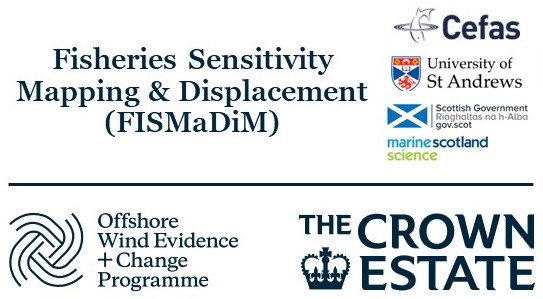Case Study

The FiSMaDiM (Fisheries Sensitivity Mapping and Displacement Modelling) project started in September 2022 and will be completed in August 2024, and aims to map areas of high importance for the fishing industry, and the economic impact that potential offshore windfarms development will have on fishing activity. The project is funded by The Crown Estate Offshore Wind Evidence and Change (OWEC) programme, and is co-led by Cefas, the Coastal Resources Management Group at the University of St Andrews, and Marine Science Scotland.
To successfully deploy offshore windfarms (OWFs) in UK waters, developers are legally required to consult with stakeholders and to collect evidence supporting the consent application process. This can present a challenge with respect to commercial fisheries because current approaches for assessing potential impacts from OWF are not robust. A better understanding of the sensitivities of fishing activities to OWF is needed to identify areas that are high and low risk areas of conflict between the two industries. High risk areas of conflict between commercial fishing and OWF can lead to objections and significant delays to the consultation process for OWFs as the economic stakes for the fishing sectors are high. In contrast, it can be assumed that in areas characterised by lower levels of fishing activity, the conflict with OWF will be low as well. In addition to the delay of the consultation process, there is the risk of high costs for compensation/cooperation payments to fishers for any displacement and other mitigation measures required.
This project reviews and tests existing tools, data and models to: (1) identify the recent spatial distribution of fishing activities of UK vessels in the UK Exclusive Economic Zone (EEZ) based on individual vessels’ positional tracking data, fisheries activity database and relevant ancillary data collected by Marine Management Organisation (MMO) and Marine Scotland; (2) assess the constraints and opportunities for the fishing industry to adapt (including displacement) to the local development of OWFs using an agent-based modelling approach.
Combining these two aspects will enable a holistic assessment of the economic impact that the introduction of OWFs have on the fishing sector and therefore provide evidence to inform the consultation process. A web-based tool will be created, which will incorporate the results of the models and data evaluated to best explain current fishing activity, as well as potential economic impacts of OWF sites on the fishing sector including the assessment of displacement of these fishing activities.
First results were presented in September 2023 in Edinburgh to the Project Advisory Group and other interested stakeholders.
Watch these talks about FiSMaDiM presented by PI Angela Muench at the 5th and 6th Scottish Marine Energy Research (ScotMER) Symposia, in January 2023 and February 2024 respectively.
| OUTPUTS | |
| Title | Year |
| 1. UK Fisheries Activity Data Overview | 2023 |



